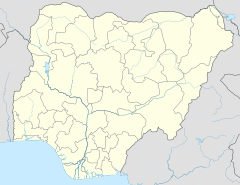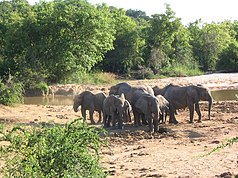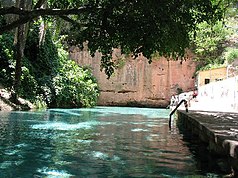Yankari National Park
| Yankari National Park | ||
|---|---|---|
|
|
||
| Location: | Bauchi , Nigeria | |
| Specialty: | Grass savannah | |
| Next city: | Gomba | |
| Surface: | 2244 km² | |
| Founding: | 1962/1991 | |
| Visitors: | 20,000 (2000) | |
| African elephants | ||
| Wikki Warm Springs | ||
The Yankari National Park ( Yankari National Park ) is a national park in eastern Nigeria .
geography
The Yankari National Park is located in the south of the dry savannah in the greater Sudan landscape and consists of grass savannah and forests. The height of most of the hills is between 200 and 400 meters, the highest point is Kariyo Hill at 640 meters . The main entrance to the west of the national park is near the village of Mainamaji , about 120 km southeast of Bauchi , the capital of the state of Bauchi . The entire area is in the Local Government Area Alkaleri .
The annual rainfall in the park is between 900 and 1000 mm, the rainy season of the West African monsoons lasts from May to September. Temperatures usually fluctuate between 18 ° and 23 ° C. In the dry season, however , the dusty Harmattan often brings temperatures of 12 ° C at night. The highest daily temperature, 40 ° C, is measured in the months of March and April.
Animal life is dependent on the Gaji River and its tributaries. The Gaji is the only watershed and divides the park in two.
history
In 1953, the regional commission for the protection of wild animals recommended that a test reserve be set up in Bauchi. The proposal was supported by the then Environment and Agriculture Minister, Alhaji Muhammadu Ngeleruma , who had already visited a Sudanese wildlife reserve. The administration of the Protectorate of Northern Nigeria approved the application in 1956, and the opening followed on December 1, 1962 as the first wildlife reserve in Nigeria. In 1991 the area received national park status.
fauna
The park management identified so far 52 different species of mammals, including African elephants , baboons , patas monkey , vervet monkeys , roan antelope , West Africa hartebeest , lion , African buffalo , waterbuck , bushbuck and hippo .
The park is home to over 350 species of birds, 130 of which are native, 50 migratory birds that roam between Africa and Europe, and the rest are migratory birds within Africa. They include the saddle stork , the Bengal vulture , the helmeted guinea fowl , the gray tokko and the cattle egret .


